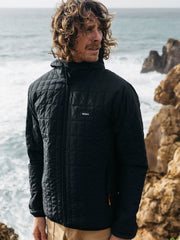Jack Lowe's ambitious photography project celebrates the volunteers who have saved 142,200 lives since the RNLI was founded, such as Finisterre founder and St Agnes helm Tom Kay. We caught up with Jack to hear more about his project and the process of making his images in the field.
About The Volunteers, For The Volunteers | The Lifeboat Station Project
02.02.22
4 min read
Interviews by Rachel Buchanan
Images by Abbi Hughes, Jack Lowe, Tom Wiersma, Duncan Davis and John Chennells
"This is my pager. Along with my wallet, phone, keys (and dog) it goes everywhere with me. A lot of people don’t know what one looks like and most of the time I don’t really notice it. Until it goes off."
"As soon as my pager goes off, I get a huge surge of adrenaline. I stop what I’m doing, grab my keys, jacket and dog, before getting down to St. Agnes lifeboat station as quickly (but safely) as I can. The station is about 250metres form the Finisterre workshop on the North Coast of Cornwall. I’m immediately thinking what the conditions are like out at sea; swell, tides, wind.
Once in the boathouse we are briefed whilst we get into our dry suits and the shore crew get the boat ready; we have two crew and one helm on our boat, which is a 14ft RIB. The helm will brief the crew and shore crew as to our intentions and likely hazards on the shout, and we’re off.
St. Agnes is a surf station and we’ll often be punching out through 6ft of surf, so the launch and recovery are pretty crucial, but it’s what we train for. The majority of our shouts are quite close to shore, in and around the beach zones and we can be the only means of rescue, so it’s an important service; something I’m really proud to be a part of."
Tom Kay is a helm on the St. Agnes boat and has been part of the crew for 15 years; he is one of 4,800 crew members based at 238 stations around the UK and Republic of Ireland who drop everything to answer a shout, saving more than 142,200 lives since the RNLI was founded in 1824. The RNLI is a charity and relies on public support.
“About the lifeboat volunteers, for the lifeboat volunteers.”
Celebrating the RNLI volunteers and all they do, leaving them a legacy that sings about their bravery and amazing work in a modern world where they’re perhaps taken for granted, is Jack Lowe and his Lifeboat Station Project.
Photographer and longtime RNLI champion and supporter, Jack Lowe is creating one of the largest projects ever undertaken in the history of photography. Travelling in his mobile darkroom (the decommissioned NHS ambulance Neena) Jack is using an ancient process to make photographs on glass as the Victorians used to between the 1850s and 1880s, photographing every RNLI station, to create an unprecedented photographic documentation and a complete body of beautiful, engaging work.
“I love photography in all its forms but I feel so conscious of the proliferation of digital photography. It’s everywhere and in such high volumes. That can be wonderful but it can also feel asphyxiating.
So, if I was going to make a new body of work, I knew it had to special and I knew I wanted to make photographs again."
Jack came to photograph the St Agnes lifeboat and crew in March 2017 and has since gone onto photograph 100 stations, aiming to complete the project by 2020. We caught up with him to talk about the project, his thoughts on the process and the importance of the RNLI volunteers.
Can you tell us a little about the process and how it works in the field?
"I fondly remember converting my bedroom into a darkroom when I was twelve years old. I spent years learning to develop film and print from the negatives. I wanted to work like that again, making beautiful photographs and, this time using a beautiful, captivating process.
By using Wet Collodion — a process first invented in 1851 — I’m making photographs that are unreproducible and un-editable. That’s unheard of in modern photography and can be a little hard to get our heads around. The pieces of glass on which I’m making the photographs are in the camera at the location at the time. The glass plates have made the journey to every lifeboat station. They are the finished photographs and, in essence, unique sculptures. I love that.
Furthermore, the process dictates that I must develop the photographs on the road and must be completed within a ten to fifteen minute window.
How do you involve the crews that you meet and photograph and why is that important?
Whenever I can, I try to involve the crew members in the process. I encourage them to step into Neena to look over my shoulder as I develop and fix the plates. The magical experience never fails to wow people and it’s a great chance to show exactly what I’m trying to achieve during my time with them.
The process has become the key to unlocking the level of engagement and participation I need to make The Lifeboat Station Project a success, and it works even with the most skeptical lifeboat volunteers!
The crews know they’re part of something special, something historical. They talk about their experience long after I’ve gone. People who wouldn’t normally buy photographs feel compelled to own the prints, not least as they know it helps support my work enabling me to carry on.
Follow the project
After every station visit The Lifeboat Station Project website and map is updated and Jack regularly posts on Instagram, Twitter, and Facebook.

















































































